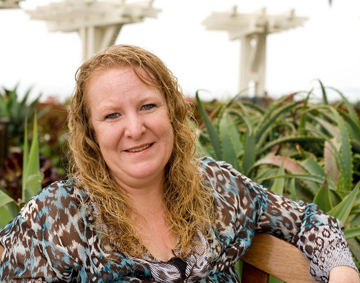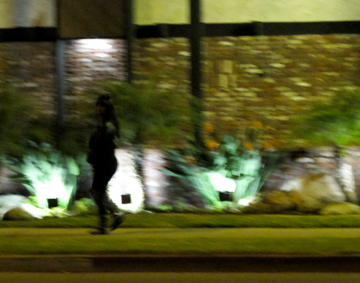 Wendy Barnes escaped a life of forced prostitution and is now an advocate helping young girls escape sex slavery. (Photo credit: Wendy Barnes) Wendy Barnes escaped a life of forced prostitution and is now an advocate helping young girls escape sex slavery. (Photo credit: Wendy Barnes) |
If she loved her daughter, she would do this for her boyfriend. If she wanted to feed her three-month-old daughter, she would sell her body. “It would just be this one time”, he told her. Seventeen, scared and desperate to feed her baby girl, Wendy Barnes turned her first trick. That night started a life of slavery that would last for 12 years.
Barnes was a normal high school girl living in Seattle, Washington when she met Greg, a seemingly kind boy who became her high school boyfriend. Just a few years later, things changed.
Greg began to verbally and physically abuse her. She wore no physical chains, but nothing she did was by choice. She was the victim of calculated manipulation for years by a man who convinced her he loved her.
Human trafficking and sex trafficking isn’t just happening overseas or in history books. Trafficking happens every day on the streets of Los Angeles and in just about every city in America.
Trafficking is not a new issue. In the documentary film, “Flesh: Bought and Sold in the U.S.,” John R. Miller, former director of the U.S. Department of State’s Office to Monitor and Combat Trafficking In Persons, says trafficking is simply a euphemism for “modern day slavery in a modern day slave trade” – a slave trade larger than any previous time in history.
According to Kevin Bales, author of “Disposable People,” there are currently an estimated 27 million slaves held in captivity worldwide and hundreds of thousands exist here in the United States.
Human trafficking is the fastest growing criminal industry, according to the U.S. Department of Health and Human Services, bringing in an estimated $32 billion a year.
The common perception of prostitution is that it is a profession of choice. That may be the case for some. However, the majority of prostitution is by force. It is sex trafficking, a specific form of human trafficking, rampant on the streets of L.A.
“I would say that the majority [of prostitutes] have been coerced, whether it’s at a younger age or by economic means,” said Kristin Lauterbach, director of “Flesh: Bought and Sold in the U.S.”
 A South L.A. Motel. A South L.A. Motel. |
The average age of entrance for girls into prostitution is 12 to 14 years, according to the U.S. Department of Justice. This is before the age that a girl can even give meaningful consent. The pimps’ sexual exploitation of these minors automatically qualifies as human trafficking.
“Even if you have a prostitute on the streets that is 21, the odds that she’s been on the streets since she was 14 years old are very high,” says Lauterbach.
While international trafficking is a huge problem in America, the majority of sex trafficking here in L.A. is domestic. The trafficked girls are often from L.A. neighborhoods, a fact that Kristin Humphris, an LAPD officer in the Prostitution and Human Trafficking Division of the Vice Unit, says many citizens find shocking.
“The general public doesn’t even think that pimping is a real thing. When I talk to people about the issue, they always say, ‘What? You’ve got to be kidding me. Our own children from L.A. are literally kidnapped off the street and forced into prostitution?’ And the sad thing is that it’s absolutely true,” says Humphris.
Many vice officers say the pimps that take advantage of these girls don’t tell the girls up front that they are pimps. Many times, like in Barnes’s case, they form a friendship with the girl, telling her she’s beautiful, buying her things, and even meeting her family.
“When he first meets somebody, he’s not going to tell them he’s a pimp. He’s not going to even let them know he’s a pimp.” Barnes says they tell girls they love them and that they’re special. “He gets to know them on a very, very deep level, finds out what their fears are, finds out what their likes are. And he plays on all of that.”
 A young prostitute walking the street in South L.A. A young prostitute walking the street in South L.A. |
Barnes says once a girl is completely dependent on her pimp, he takes it all away. She says that once they have a hold on a girl’s mind, they coerce her into prostitution and manipulate her to depend on them for everything.
Barnes says the abuse she experienced was both physical and psychological and that many times, Greg would threaten to kill her or her mother if she ever contradicted his orders. He controlled every aspect of her life.
“Everything that we did, said, breathed was determined by him. If you broke the rule whatsoever, at all – if you did not do or think the way he wanted you to think, you would suffer for it,” remembers Barnes. “He would either do something to your parents, to me, he would do something to the house. He would always find that thing that destroyed you the most.”
Kay Buck, executive director of the Coalition to Abolish Slavery and Trafficking in L.A., says this type of control is the norm for human trafficking.
“So many people think that victims are handcuffed to a bed or locked somewhere, but the reality is that this modern day slavery is a lot more about threats and coercion. So what happens instead is that traffickers threaten victims with their lives,” says Buck. “They use these threats and tactics to control victims which have proven to be very effective. Victims are afraid for their lives and the lives of their loved ones back home.”
Barnes was not the only girl that Greg held using these kinds of tactics. During her first five years with Greg, Barnes was aware of more than 300 girls that were under his control.
Many pimps control several girls and operate within a trafficking ring. They will rent out houses or hotel rooms and stay there with the group of girls. After a while, they will pick up and move to another city. Greg’s trafficking ring, for example, spanned from Seattle all the way to Southern California.
“These traffickers, or pimps, move these girls around and the whole purpose of that is to isolate them, confuse them, and avoid detection and prosecution,” says Humprhis.
 Family pictures adorn Wendy Barnes’ current home, a sign of happier times after a painful past. Family pictures adorn Wendy Barnes’ current home, a sign of happier times after a painful past. |
California state law dictates that the punishment for the pimping and pandering of minors under the age of 16 is imprisonment for three to eight years. For pandering and pimping minors between the ages of 16 and 18, the imprisonment time is reduced to three to six years.
According to a report released by Shared Hope International, the punishment for pimps and “johns” (the purchasers of sexual services) is not adequate enough. The report, which assigned states grades for their efforts in fighting sex trafficking, gave California an F.
The section of the report that California did the worst in was “criminal provisions addressing demand.” LAPD Officer Humphris says that as a society we need to give a greater punishment to the people seeking the sex act.
“Those are the ones that are shopping around for kids. There’s a 12 year-old on the street. Someone is buying that, and there’s just not much in place, unfortunately, as far as the law goes, to have a big impact in enforcing,” says Humphris.
Humphris also believes that many “johns” do not know how young some of the girls on the streets are or that they’re being forced to do things against their will, under the control of a pimp. “I feel like if that was more widely known, someone with a conscience might try to police themselves a little,” says Humphris.
Advocates against human trafficking say awareness is a large issue with the general public. Lauterbach says that many people don’t stand up against trafficking simply because they are unaware of its existence all around them.
“What we advocate for so much is education, because the next steps are natural. If you see someone who is being victimized, you can do something about it. But if you don’t realize they’re being victimized, you’re not going to do anything about it,” says Lauterbach.
In recent years, the LAPD Vice Unit has become aware many girls in prostitution are sex trafficking victims. Lauterbach says that when she first started her documentary, she couldn’t find police who truly understood the victimization of these girls, but now is encouraged by the vice unit’s awareness and efforts to stop trafficking.
“We rode along with the central vice unit and they get that this is human trafficking, they get that these girls are coerced, and they work so hard to get girls out – they work so hard to be able to prosecute the pimp to get them off the street,” says Lauterbach.
While the LAPD Vice Unit has grown in their efforts to respond to sex trafficking, the issue itself has expanded to affect a growing population of girls in recent years. Buck has seen CAST L.A.’s cases more than double in the past three years, and Humphris has seen the growth on the streets as well.
“I would say it’s probably gotten worse and it seems to me that the kids are even getting younger that are entering into prostitution,” says Humphris.
While the problem seems daunting, Barnes’s life is a testament to the possibility of freedom and a new life. After 12 years of slavery, police raided Greg’s home and sent Barnes to prison where she served two years. Finally on her own, she is experiencing the joy of simply living a normal life.
“People don’t realize how precious life is. Like just going out and laying out in the grass. How amazing is that? I can think back and Greg would not allow us,” said Barnes. “Just freedom to walk from here to there, without getting yelled at, without being asked why.”
If you walked into Barnes’ home today, you would never suspect she had a hard and painful past. Her visitors are greeted by smiles and family pictures decorate the walls of Southern California the home she shares with her daughter Latasha.
Barnes has worked at the same job for the past five years and enjoys every moment of what most call an ordinary life. However, her life is anything but ordinary. Her life is now a picture of hope, showing that it is possible to come out of slavery and enter into freedom.














